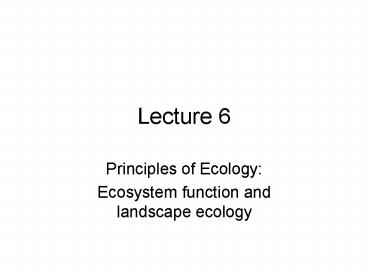Principles of Ecology: PowerPoint PPT Presentation
1 / 42
Title: Principles of Ecology:
1
Lecture 6
- Principles of Ecology
- Ecosystem function and landscape ecology
2
Lecture 6 topics
- Ecosystem function
- Producers, consumers and decomposers
- Nutrient cycling
- Carbon cycling and C sequestration
- Landscape ecology
- Importance of riparian areas
3
Ecosystem function
- Most important functions are energy and nutrient
cycling
3
4
Energy
CO2
O2
Water
Sugar
4
5
CO2
O2
Water
Sugar
Energy
5
6
6
7
Organisms in an ecosystem may be identified by
how they obtain their food.
7
(Miller 2002)
8
Pyramid of Energy Flow
8
(Miller 2002)
9
2. Producers, consumers and decomposers
- Fluxes of nutrients and carbon are controlled by
producers, consumers and decomposers as well as
by the hydrologic cycle.
9
10
10
11
(Miller 2002)
Cycle of Matter and Energy between the main
Structural Components of an Ecosystem
11
12
3. Nutrient cycling
- Most important nutrients are
- N
- P
- Ca
- Other cations (K, Mg)
- S
12
13
13
14
14
15
15
16
Another N cycle
16
17
P cycle
17
18
18
19
4. Carbon cycling and carbon sequestration
- Carbon inputs to ecosystems are largely through
photosynthesis. Carbon outputs are through
respiration, dissolved organic and inorganic
carbon and removal of forest products. - Carbon sequestration occurs when inputs exceed
losses. - How effective are forests at sequestering
Carbon?
19
20
20
21
21
22
5. Landscape ecology
- Landscape ecology addresses how spatial variation
(heterogeneity) in the landscape affects
ecological processes such as the distribution and
flow of energy, materials and individuals in the
environment. It includes the study of the
landscape pattern - It stresses the role of human impacts on
landscape structures and functions and proposes
ways for restoring degraded landscapes. It
explicitly includes humans as entities that cause
functional changes on the landscape
22
23
Satellite data, aerial photos and GIS are tools
of landscape ecology
23
24
24
25
GIS an important tool
25
26
Patch and mosaic Patch - relatively homogeneous
area that differs from its surroundings. Have
definite shapes and configurations. Patch
dynamics - Patches change and fluctuate. Matrix
- background ecological system of a landscape
with a high degree of connectivity. Connectivity
- measure of how connected or spatially
continuous a corridor, or matrix is. e,g,, a
forested landscape (the matrix) with fewer gaps
in forest cover (open patches) will have higher
connectivity. Corridors have important functions
as strips of a particular type of landscape
differing from adjacent land on both sides.
Connect habitats. Network - interconnected
system of corridors Mosaic - describes the
pattern of patches, corridors and matrix that
form a landscape in its entirety.
26
27
U.S. Forest Service/BLM landscapes
- The Northwest Forest Plan in 1994 divided the
federal forest landscape in each National Forest
and BLMs land into - Matrix timber harvesting allowed
- Old-growth reserves
- Riparian reserves
- Adaptive management areas
27
28
Boundary and edge Boundary - The zone composed
of the edges of adjacent ecosystems Edge -
portion of an ecosystem near its perimeter.
Edge effect - distinctive species composition
or abundance in the outer part of the landscape
patch.
28
29
Ecotones A type of boundary is the ecotone, or
the transitional zone between two communities.
Ecotones lakeshore or riparian zone, or
human-created (cleared agricultural field and a
forest). The ecotonal community retains
characteristics of each bordering community and
often contains species not found in the adjacent
communities. Species richness may be higher or
lower than either side of the ecotone.
29
30
Wildlife corridors, riparian areas, ecotones,
edges, and connectivity are all illustrated here
30
31
Forest edges in Washington
31
32
Disturbance and fragmentation Disturbance -
alters the pattern of variation in the structure
or function of a system, Fragmentation -
breaking up of a habitat, ecosystem, or land-use
type into smaller parcels. Disturbance is
generally considered a natural process.
Fragmentation causes land transformation, an
important current process in landscapes as more
and more development occurs.
32
33
Landscape ecology is important in the
understanding of Fire Insect outbreaks
(defoliators, bark beetles) Global change
(temperature, moisture, snow pack
changes) Urbanization Other big scale things
33
34
Fires
34
35
What caused this?
35
36
Landscape temperature
36
37
6. Riparian areas
Type F
Jeff Grizzel, WA DNR
37
38
Importance of riparian areas
- Ecotone between stream and lake ecosystems and
upland forest ecosystems. Buffer natural and
human caused disturbances. - High biodiversity
- Species are different than upland. More hardwoods
because of high frequency of disturbance. Should
we replace red alder with conifers because they
provide longer lasting LWD. - Moderate stream temperatures through shading
important for fish - Modify nutrients coming from uplands and marine
environments (marine derived nutrients)
38
39
39
40
Alder versus conifers in riparian areas
ONP 3 sites Snider Twin West Twin
DNR 3 sites Alder Canyon Lindner
40
41
NO3-N in alder and conifer streams
R20.90
NO3-N, mg L-1
red alder in watershed
41
42
Alder sites as compared to conifer sites
42

